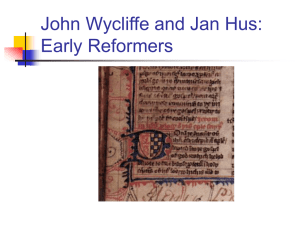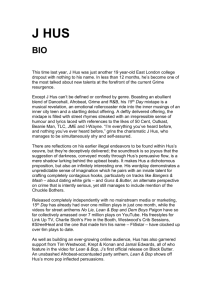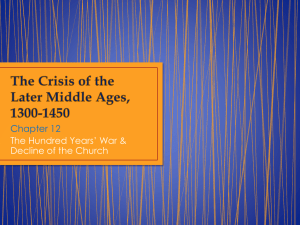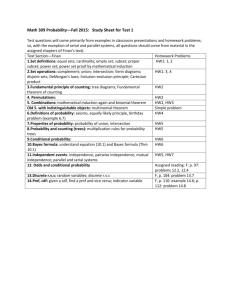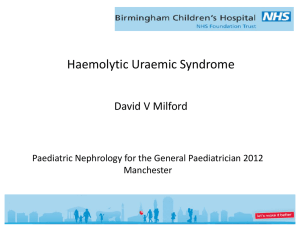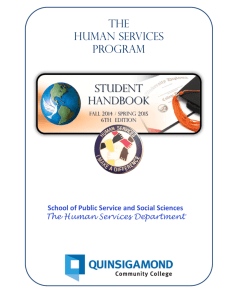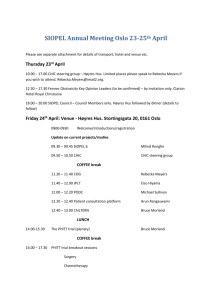The Eve of the Reformation
advertisement
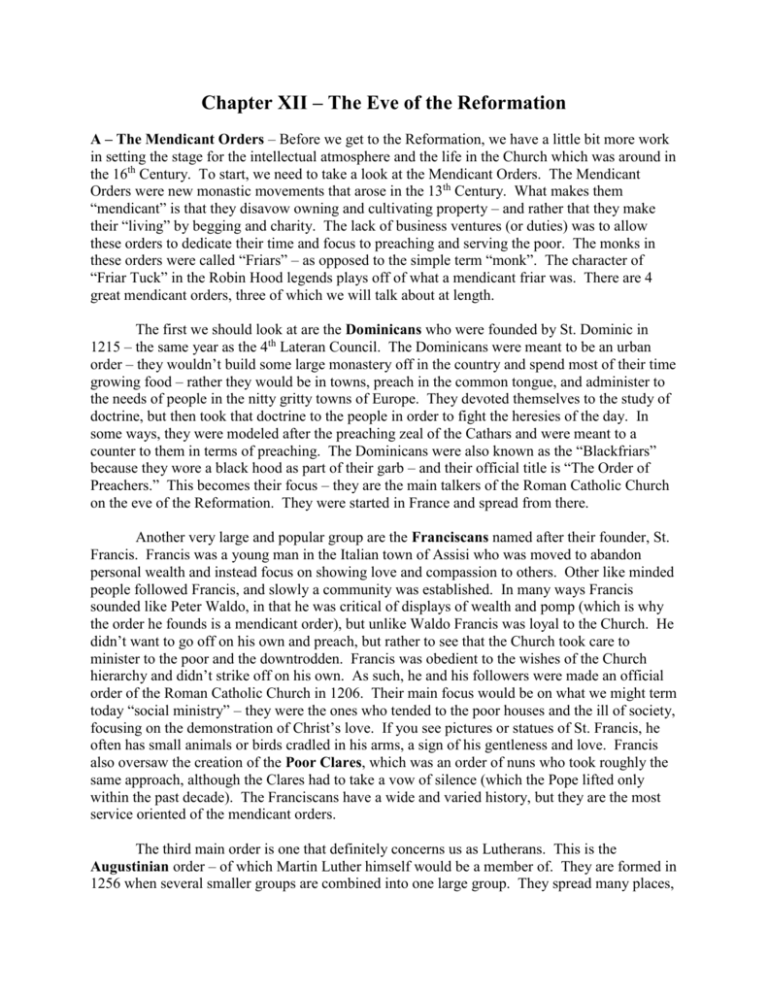
Chapter XII – The Eve of the Reformation A – The Mendicant Orders – Before we get to the Reformation, we have a little bit more work in setting the stage for the intellectual atmosphere and the life in the Church which was around in the 16th Century. To start, we need to take a look at the Mendicant Orders. The Mendicant Orders were new monastic movements that arose in the 13th Century. What makes them “mendicant” is that they disavow owning and cultivating property – and rather that they make their “living” by begging and charity. The lack of business ventures (or duties) was to allow these orders to dedicate their time and focus to preaching and serving the poor. The monks in these orders were called “Friars” – as opposed to the simple term “monk”. The character of “Friar Tuck” in the Robin Hood legends plays off of what a mendicant friar was. There are 4 great mendicant orders, three of which we will talk about at length. The first we should look at are the Dominicans who were founded by St. Dominic in 1215 – the same year as the 4th Lateran Council. The Dominicans were meant to be an urban order – they wouldn’t build some large monastery off in the country and spend most of their time growing food – rather they would be in towns, preach in the common tongue, and administer to the needs of people in the nitty gritty towns of Europe. They devoted themselves to the study of doctrine, but then took that doctrine to the people in order to fight the heresies of the day. In some ways, they were modeled after the preaching zeal of the Cathars and were meant to a counter to them in terms of preaching. The Dominicans were also known as the “Blackfriars” because they wore a black hood as part of their garb – and their official title is “The Order of Preachers.” This becomes their focus – they are the main talkers of the Roman Catholic Church on the eve of the Reformation. They were started in France and spread from there. Another very large and popular group are the Franciscans named after their founder, St. Francis. Francis was a young man in the Italian town of Assisi who was moved to abandon personal wealth and instead focus on showing love and compassion to others. Other like minded people followed Francis, and slowly a community was established. In many ways Francis sounded like Peter Waldo, in that he was critical of displays of wealth and pomp (which is why the order he founds is a mendicant order), but unlike Waldo Francis was loyal to the Church. He didn’t want to go off on his own and preach, but rather to see that the Church took care to minister to the poor and the downtrodden. Francis was obedient to the wishes of the Church hierarchy and didn’t strike off on his own. As such, he and his followers were made an official order of the Roman Catholic Church in 1206. Their main focus would be on what we might term today “social ministry” – they were the ones who tended to the poor houses and the ill of society, focusing on the demonstration of Christ’s love. If you see pictures or statues of St. Francis, he often has small animals or birds cradled in his arms, a sign of his gentleness and love. Francis also oversaw the creation of the Poor Clares, which was an order of nuns who took roughly the same approach, although the Clares had to take a vow of silence (which the Pope lifted only within the past decade). The Franciscans have a wide and varied history, but they are the most service oriented of the mendicant orders. The third main order is one that definitely concerns us as Lutherans. This is the Augustinian order – of which Martin Luther himself would be a member of. They are formed in 1256 when several smaller groups are combined into one large group. They spread many places, but tended to be very popular in Germany. They claimed that their “order” or rules for living was based upon the teaching of St. Augustine. They were mendicants as well – but their focus was slightly different than the Dominicans and the Franciscans. Instead of focusing on preaching or service, the Augustinians were the teaching order – they dealt with the spread of knowledge. Interestingly, they don’t end up producing the great theologians (prior to Luther), mainly because they are the practical, busy teachers. The final main mendicant order, which we don’t hear so much about in history, are the Carmelites, a group which started upon Mt. Carmel, giving them their name. The Carmelites had a particularly strong devotion to Mary, and their main thrust was prayer. They prayed for the world – that was what they saw as their main task. As such, they are around, but not as active in the events that shape the history of the Church. Occasionally the Carmelites will help bring forth an innovation in worship, but that tends to be their main impact. These four orders end up becoming the most popular and dominant types of monks in the Roman Catholic Church on the eve of the Reformation. While there still are Benedictines and Cluniac monks, as the fervor of the 11th and 12th Century dies down, these orders, each of which is devoted to a particular service in the Church take over. One might almost look at these orders the way a person might look at a major in college – depending on what type of work one wanted to do in the Church, one would pick out one of the orders. These orders will shape the history of the Church. B – The Early Scholastics and the Rise of the University – In addition to developments in the monastic life of the Church, there is a rise in philosophy and learning in general which begins around 1000 or so until the Reformation. This movement is called “Scholasticism” where men of the faith tried to reconcile what is taught in Christianity with what they were continuing to learn and rediscover of ancient philosophy. These were the creative thinkers, who studied scriptures, asked questions, and came up with theories to answer those questions. The early scholastics tended to be just the highly educated folks within the Church. An example of this is St. Anselm (1033-1106). Anselm was the leader of a monastery at Bec who did much with learning and later on went on to the be archibishop of Canterbury. Anselm is the most important theologian to the Church since Augustine, as he really kicks off the focus on learning and study again. He sought to understand the reason and logic of the Christian faith – or as he would put it “I hold it to be a failure in duty if after we have become steadfast in our faith we do not strive to understand what we believe.” As such, Anselm tackles a lot of the troubling questions of the day. He argues for the idea of Absolute Truth. He comes up with the “ontological” proof of the existence of God, one of the most interesting philosophic arguments ever made. He also does great work on the Trinity. However, his greatest work, and one that we appreciate to this day, is his book “Why Did God Become Man?” What he does in this book is explain why it is necessary that Jesus become Man and suffer and die. The stress that Anselm puts on this idea is that as a man sinned (Adam and us), there needed to be a perfect Man who would please God. This was Jesus. Likewise, as men have sinned, there needed to be a Man – namely Jesus – who would take our punishment for us. Anselm writes the classic work on explaining the atonement in terms of Jesus earning salvation in us and paying our punishment, which we delight in to this day. Anselm and his work really gets the ball rolling on the idea of study, of doing the work of further defining knowledge and answering questions. This leads to the development or creation of what is called the “University”. A University would be simply a place of study and learning. Unlike a monastery, the students at a University wouldn’t be monks. Unlike in the Church proper, they wouldn’t be priests. They would simple be students dedicated to the study of knowledge, especially Philosophy, Theology, Law, and (later) Medicine. These were meant to be new renditions of the schools of the ancient world. The first modern “University” was the University of Bologna in Italy, founded in 1088. Paris has a university right around 1100. As the Centuries progress, more and more Universities are established, and these become centers of learning and debate. There is another famous early scholastic that we should mention – and this is Peter Lombard (1100-1160). Lombard was an Italian who ended up moving to France (and Paris) to study theology. He writes what is called “The Sentences” – which is basically the first “systematic” theology. A systematic theology is where several topics in theology are arraigned in order and then discussed. Rather than simply commentating on an individual topic or book of Scripture, the Sentences took a string of ideas in scripture and explained each one in order and showed how they connected to each other. This is one of the major ways of doing theology (think of the Small Catechism, for example – that is a systematic approach to theology). C – Thomas Aquinas – The dean of all the scholastics, the brightest and “best” of them, would be Thomas Aquinas. Aquinas is the Roman Catholic theologian of the middle ages – in fact many Roman Catholics might label him as the greatest theologian ever. Aquinas was born in 1225 in Italy into a noble family., and was obviously gifted intellectually. He studied at the University of Naples, and while there, he came under the influence of several Dominicans. In spite of the displeasure of his family, Aquinas joined the Dominican order at 17. While in the Dominican order, he continued his studies, including in Paris and Cologne. The Dominicans were the preachers, the ones who wanted to be able to preach doctrine, so they were glad to produce a good scholar who could help explain things. There is some evidence that Aquinas was not that great of a speaker, so he focused more on teaching. He eventually becomes a professor in Paris, but he ends up teaching all over Europe. Aquinas writes tons and tons of stuff, but his most famous writing is the “Summa Theologiae” – the great compendium of systematic theology. He never quite finishes it, for it is a mammoth project. He addresses a couple of ideas in it, some great, some not so, that we will look at now. Aquinas had a special focus on what is called “Natural Theology” due to his love of theology. Aquinas put a emphasis on the distinction between general revelation and special revelation. General revelation is the things about God we can determine using philosophy and reason – where as special revelation is that which is revealed by God – chiefly in His Word. Aquinas says that by simply looking at the world you can tell that God is powerful – but you can only learn of His love for us through His special revelation. The doctrines that make us Christian – the Trinity, the Incarnation, the plan of salvation, these are all part of God’s special revelation. This is a distinction we still use to this day. As Aquinas made the distinction between general knowledge and revealed knowledge, he also helps to introduce the idea of the “Hidden God (Deus Absonditas)” and the “Revealed God (Deus revelatus)”. To learn many of the truths about God, we rely on what He reveals to us. However, he doesn’t reveal to us everything about Him. There are some questions about God that we cannot answer. Moreover, because God is infinite and we are finite, we can only know about Him by way of analogy – by way of comparison. For example, we can say that God is good – but we don’t get the fullness of God’s goodness – we can only conceive of goodness by what we have seen – but God’s goodness is even beyond that. As such, Aquinas liked saying what God is not – He is infinite (or not finite or bound). Also, in terms of Philosophy, he has some wonderful work on the proof of God. One that he brings up that is around to this day is “Design proves the existence of a Designer.” The fact that things are crafted in the world implies that there is a crafter – and this must be God. The “and this must be God” isn’t really a nice piece of logic, but the same argument is made to this day, especially by folks who want to have Intelligent Design taught in schools. One of his more famous proofs is that of the “Unmoved Mover”. Aquinas sees that things are moving in the world, there fore someone had to put them into motion – an “Unmoved Mover” – one who isn’t moved, but moves things. This is wild, groundbreaking philosophic work. Aquinas does so much more stuff, tons and tons. And some of it isn’t as good. He comes after the 4th Lateran Council, so he ends up doing a lot of the theological justification of the decisions of that council. This is what Dominicans did – and Aquinas was fantastic at that. He writes the classic explanation of Transubstantiation. He basically sets the explanation of what happened at the 4th Lateran Council – and as that is such a pivotal event in the history of Rome, Aquinas takes a high place in the history of the Church. D – The Late Scholastics – After the time of Aquinas, the development of scholastic thought continued, and the Universities began to expand and grow. Several great thinkers blossomed in this time, and not just in theology, but also spreading out into other areas. Where as in the Church thought had been given primarily to theology, after 1250 more and more of the great thinkers also devote time to “Natural Philosophy” – or science as we would call it today – and psychology and math. Soon, most of the fields we think of when we think of a college education appear. While we aren’t going to spend a great deal of time looking at the thinkers of this era, we should point out a few, and use them as examples of how the intellectual setting of the Church is changing. The first of these Late Scholastics that we should talk about is Roger Bacon (12141294). Bacon was born in England and studies at Oxford, where he very quickly became a leading scholar on Aristotle – he was one of the first in Christian Europe to study the thinker. He ended up joining the Franciscan order and serving at the University of Paris. His main intellectually contribution is helping to reintroduce the idea of the scientific method back into Western Culture. Throughout the dark ages, when there had been questions of science or how the world worked, the questions would be debated. People would rely on what they had been told by tradition, and the most convincing argument would take the day. Bacon, on the other hand, favored using Aristotle’s method of experimentation. The way to determine the truth of the physical world is to not simply talk about something, but look and see and record. This stance actually made him very unpopular, and part of his life he spent in exile in monasteries when he happened to upset his supervisors (who favored the more old fashioned means). His great work was the Opus Majus, which deals with math and science, how to make gunpowder, and even anticipates the invention of the telescope. Bacon also had some interesting critiques of the way in which theology was done. Although theology wasn’t his main focus (the fact that a thinker can focus elsewhere than theology shows how the intellectual setting of Europe is changing), Bacon has some fantastic insights. Bacon was a lover of language, and as he studied Aristotle, he was one of the first Northern Europeans in centuries to learn Greek. Having learned Greek and other languages, he saw and understood just how bad some of the Latin translations of Aristotle were. Thus, he thought that the theologians should move back to Scripture for their discussion and research, and preferably the Greek, rather than just arguing over the positions people before them had taken. Bacon does finally have some other interesting things to note about him. He was generally considered to be a major proponent of Alchemy – a semi-mystical practice focusing on altering the world. This eventually in the west would be modified and tamed by scientific thought into the practice of Chemistry. Bacon also studied astrology – and happened to think that the “heavenly bodies” had an influence on our daily lives. So there definitely were some quirky things he thought. However, he advanced the direction of knowledge greatly. The next scholar to look at is Duns Scotus (1266-1308). As his name suggests, he was born in Scotland, and grew up in Oxford, finally teaching in Cologne. What is important about Scotus is that his work really helps to separate the different aspects of learning from each other. Scotus is the person who observes that the way you deal with theology is really different than how you deal with science which is really different than how you deal with philosophy. Those different intellectual pursuits, although all involving the mind, have different rules that need to be followed. This is a given for us today, but Scotus is the one who pushes for the difference. This is why he is important. His work itself, eh, it isn’t so great. In fact, later critics lambasted him so badly that even today a “Dunce” is known as a. . . well, dunce. Theologically, he was a defender of the idea that Mary was Immaculately Conceived, or born without original sin. His work does help to popularize this idea. Also important is Marsilius of Padua (1270-1342). Marsilius is an interesting case. Born in Italy, he didn’t spend his entire life as a scholar. Growing up, he bounded from job to job, even serving as a soldier. It wasn’t until 1311 that he went to Paris and began his studies in earnest. He was mostly interested in Medicine, perhaps because of his background as a soldier, but once in Paris he also branched out into theology and what we might call political science. His great work is the Defensor Pacis – or the Defender of Peace. This book was written against the backdrop of the abuses of the Avignon Papacy, where the Pope, under the influence of France, was trying to establish a lot of rule in Germany (the Holy Roman Empire). Marsilius argued that the state was independent of the Church and that civil laws ought to rule society. In fact, Marsilius claimed that the Pope’s power should be shattered. The Church should stay out of temporal matters. Moreover he rejects the claims that the popes had to being solely able to interpret scripture and to declare dogma, or official teaching in the Church. The Pope would be just another bishop, although given respect due to his location – the first among equals. One of my favorite of the Late Scholastics is William of Ockham (1285-1347). Ockham was a Franciscan who lived a life of poverty, but did wonderful things intellectually. He develops a system of thought which is called by later scholars “Ockham’s razor” – which boils down to this – the simplest explanation is the most likely. For example – let us say that there is a bowl of melted ice cream sitting on your kitchen table at home. It is possible that someone in the house simply left it out. It is also possible that space aliens from the planet Bezoor came and teleported the ice cream to your table and melted it with their death ray. Ockham’s razor says you examine the easiest explanation first. Ockham also helped advance the ideas of philosophy known as nominalism. Nominalism states that the only things that are truly real are individuals. If you want to know what “man” is, you look at individual men. “Man” as such doesn’t exist outside of the mind – it is merely a concept by which we understand things. Only concrete, specific men truly exist. This ran contrary to the thought of the day. The other thing that Ockham works on is the idea of constitutional law. He builds on Marsilius’ work, and argues that the law of a Nation should be written down and clear, not just a matter of tradition (and soon we see the rise of a legal profession dealing with a written law). As such, Ockham also tended to be opposed to the power of the Papacy. When Ockham was called upon to teach in Avignon where the Papacy was, he let his views be known on both politics and “natural philosophy” and was banished and died excommunicated, although the Church rehabilitated him 11 years after his death. The final Scholastic we will look at here is Nicolas d’Oresme (1323-1382). Nicolas was born in Normandy in France and went to school in Paris smack dab in the middle of the controversy caused by Ockham’s ideas. He ended up standing the shoulders of giants, and did fantastic work in many, many fields. Some of his best known work was done in mathematics – and you probably know it. He developed a mathematical way of representing figures by graphing them – looking at how far they were from a set point. How far east and west from center was their “Longitude” and then, how far north and south on lines perpendicular from the longitude on lines know as their “Latitude.” These are the same ideas Galileo will take and apply to stellar mechanics to do all his work. They were invented and discovered by Nicolas. As he loved math, Nicolas loved another closely related field – music. Folks trained in music will tell you that it really all is math – and Nicolas exploited this relationship. Nicolas studied and wrote about almost all aspects of music, including acoustics, musical aesthetics, music theory, performance, and philosophy of music. He discovered the idea of overtones – which plays into a lot of harmonics and the like. Nicolas also did fantastic work in the realm of Psychology. He proposed the idea of an “unconscious” part of your mind – the things you do without thinking or being aware of them. His other work in the area is incredibly complex and seems to be centuries before its time – I can’t even get into them they are so advanced. He does tons of work in science – discovering that air will bend light and things like that. Copernicus and Newton both end up building on his work. By 1350, the understanding and pursuit of knowledge has grown and expanded to where all the “subjects” that we think of to this day were basically present in schools. Knowledge was no longer just a matter of talking about God, but expanded out into all the various studies we have today. You can also see how there is a move away from straight theology at schools. While theology remains a part of study, it isn’t the main focus. Thus we also have the way paved for the idea of “theologians” – men who would devote the majority of their time simply to the study of God. Now it will be theologians, men dedicated to the intellectual study of God, who will help to shape Church History. There are two we ought to look at now. E – The two Johns, Wyclif and Hus – Martin Luther was by no means the first theologian to try to reform the Church. Nor was he the first person to be hounded for his desire to do so. In fact, in the Centuries prior to Luther there were two men who attempted to reform the Church, meeting with mixed success. Although these reforms weren’t perfect and didn’t last, they do show that many within the Church did see the need for change. The first person we will look at is John Wyclif (or Wycliffe, 1324 – 1384). Wyclif was an English theologian who, with his work at Oxford, almost succeed in turning the Church on its ear. A student of Ockham, Wyclif was a gifted scholar who, even his enemies conceded, excelled at most everything he touched academically. He eventually turned his focus from math and philosophy to theology, earning a doctorate sometime in the late 1360s or early 1370s. In the realm of theology, Wyclif was a strongly outspoken opponent of the wealth of the Church. Wyclif constantly criticized the Church for its accumulation of wealth and temporal power. Also, in society and the world, Wyclif argued that civil governments and kings must outrank the Church and Pope. As such, this brought Wyclif into conflict with papal interests and also the non-mendicant monasteries. In fact, it was the response of papal and monastic influences that led to Wyclif’s fame. Wyclif had simply been a scholar who was content to quietly discuss ideas at Oxford – however, in 1377, his detractors brought him before the Bishop of London to explain his position. This Wyclif did, and suddenly almost all the clergy in England was out for his head (as Wyclif attacked their security). In the midst of this firestorm of controversy, Wyclif became convinced that Scripture alone is the true authority in the Church – not any administration or earthly organization. He also believed that people needed to have access to Scripture. So Wyclif did the only thing he thought was reasonable. He translated the Bible into English. Wyclif and several of his friends and coworkers began to put Scripture into English. This was a monumental work, and actually continued on after Wyclif’s death. Secret copy shops and early printing houses (this was before Guttenberg and his press) worked frantically to distribute the Scriptures. The Church in response cracked down on these bibles, seeking to destroy them. Church leaders cried “the jewel of the clergy has become the play thing of the laity.” Eventually, folks with Wyclif’s bible were forced to go underground and into hiding because the backlash from the Church was so strong and so unified. However, for a brief time, the Scriptures were available in English. As a sample, here is what John 1:1-5 reads like in Wyclif. “1 In the bigynnyng was the word, and the word was at God, and God was the word. 2 This was in the bigynnyng at God. 3 Alle thingis weren maad bi hym, and withouten hym was maad no thing, that thing that was maad. 4 In hym was lijf, and the lijf was the liyt of men; and the liyt schyneth in derknessis, 5 and derknessis comprehendiden not As you can see, a lot of our grammar rules weren’t establish (and spelling certainly wasn’t), but even to us today we can recognize this as Scritpure. it.” Just a few other things to note about Wyclif. He began to attack the Papacy rather bluntly. In fact, as it was the time of the Avignon Papacy, Wyclif attacked several Popes at the same time. He even seemed to imply that, while there could be a good Pope, the Popes today in the Church abuse their power and were in fact Anti-Christ – a position very close to the one a German monk by the name of Luther would take. Wyclif had great fame and influence during his life, but once he died December 31st, 1384, no other leader took up his place in England. His friends continued to work, but none was as strong a voice, and slowly the Church drowned out his cries for reform – even branding him a heretic at the Council of Constance in 1415. Wyclif’s influence did seep out of England, and it flared up a few decades later in another John – John (or Jan) Hus (1369-1415). Hus was a Bohemian theologian who was perhaps the most successful reformer of the Church prior to Luther. Hus ends up today becoming a very famous figure in the Czech Republic for his historical and cultural importance – Hus is the guy who develops dialectics for their language (the little symbols above Czech vowels) – July 6 is Jan Hus day and a federal holiday in the Czech Republic. However, we will look at him not for his cultural impact, but his theological position. Hus ends up being a professor at the University of Prague, which was one of the major universities of the world at the time. However, when Hus was there the Great Schism of the Church, with multiple Popes was on in full force. And this spilled over into the University. Many of the native German profs (and there were many at Prague) tried to remain neutral and indifferent, whereas Hus and the Bohemians supported specific Popes. And Hus led the charge – and basically drove off the German professors (who went on to form the University of Leipzig). This ended up isolating Bohemia, which for a while allow Hus to introduce some ideas of reform, many of which sounded like Wyclif. In fact, the copies of Wyclif material which Hus and the university had were ordered burned, and Hus was excommunicated in 1409. Following this, one of the Popes, John XXIII declared a crusade against the King of Naples, and sent out folks with indulgences to raise funds. Hus, who although excommunicated was still well respected in Bohemia, preached against both the crusade and the indulgences. Hus opposed the Crusades because the Pope had no business messing in the temporal affairs of the world in this way. The Pope is to pray for his enemies – not kill them. Likewise, people are to repent and be forgiven, not buy forgiveness. On these points Hus sounded almost completely like Wyclif – in fact, some of Hus’ most famous work is basically Wyclif verbatim. And most of Bohemia followed Hus. To the common folks, this made great sense. However, to the faculty, Hus had gone too far, so they started to oppose Hus and kicked him out. Hus then ended up leading local folks who basically rejected the official Church. Hus’ followers, called Hussites, also ended up calling for a few other reforms, following Hus’ lead. One of these was the demand that Communion be celebrated in “both kinds” – that is that the laity should receive both the Lord’s Body and Blood in Communion. It had become common practice where only the priests would get the Cup. Hus wanted to change that. Also, since the 4th Lateran Council clergy weren’t judged in the normal courts but separate ones. Hus wanted to change that. Hus ended up losing a lot of his protection at home as many of the local powers didn’t support him. Thus, when the Council of Constance was called in 1414 and 1415 – with the main goal of finally deciding on who the Pope was going to be – they also decided to settle the matter of Jan Hus. The council summoned Hus and Hus went, hoping to prove that he wasn’t a heretic and implement his reforms. However, upon his arrival, it became clear that there was to be no true discussion, but rather a condemnation. Eventually Hus was imprisoned and placed on trial. After 6 months of waiting, Hus was put on trial June 5th, 1415. Over the course of his trial, some of Hus’ writing were read back to him, and the Church officials demanded that he recant them. Hus first denied obvious heresies which he didn’t hold to, and then replied that he would gladly recant those things he believed if he could be shown how they were against scripture or reason (Lutherans – does this sound familiar?). The Council was not placated, and on July 6th declared Hus a heretic and sentenced him to burning at the stake. As Hus was being dragged off, he repeatedly asked for that people simply show him in Scripture where he was wrong. No mercy (or evidence from scripture) was shown, and Hus was tied to the stake. As the fires were lit, Hus was reported to have sung the Kyrie (or a long verion of it) – Christ the Son of the Living God, have mercy upon me. . . . Before he finished, the smoke suffocated him to death and he died. The Hussites as a religious group continued on for many years. As the movement grew, it ended up taking on some nationalistic overtones – to be a patriotic Bohemian eventually meant you were a Hussite. This drew great attention – even Joan of Arc offered to lead a crusade against them in 1430, just before she herself was burned at the stake. Eventually, in 1433 a semi-peace was established, and slowly the Hussites became a somewhat tolerated local variation of the Roman Catholic Church – at least until the Reformation when everything blows up in the Church. After the reformation, those who had Hussite leanings ended up joining Lutheran or Reformed Churches, and “Hussites” as a separate group faded away. Today there are around 100,000 Hussites who hold to a separate body, centered in Prague. However, the reforms that Hus wanted didn’t really catch on in many places – the hopes for a major reform burned up with Hus. F – Conciliarism and attempts at Reform – Looking at the condemnation of Hus, the first reaction of many people is confusion at why Hus would even agree to go. In hindsight, the deck looked completely stacked against him. Why would Hus be willing to go? This is because of the idea of Conciliarism. Conciliarism was a movement that developed within the Church over the course of the 14th and 15th Century which stated that the ultimate authority in terms of Church matters was not the Pope, but rather a Church Council. People could look towards Church History to argue for this. The Nicene Creed was the product of a council, not of a Pope. The great Church Councils brought all the bishops together and judged issues and problems. Once the Avignon Papacy comes about, where there are multiple Popes, the idea of a Church Council being authoritative made more and more sense to most people. If we can’t figure out who the Pope is, we should have a Council do it. You can see why many would-be reformers, like Hus, looked towards Church Councils to be the main force of reform. If we are reforming the power structures of the Church (which is what much of Wyclif and Hus focused on) maybe these Councils would be open to reforms which should be “obvious” from scripture. However, the Councils end not being interested in doing much theological reform, but rather focus mainly on power. Instead of being about reform, it was more a battle over a shift of power. While the Council of Constance marks a high point for the power of Councils in the Roman Catholic Church, Conciliarism ends up running its course over the next few decades. Once the Papacy isn’t split, the Popes are able to consolidate their power over the Church. By the 5th Lateran Council of 1512-1517, the idea of Conciliarism is officially condemned (whenever you see a “Lateran” Council you know it’s one that is in the Pope’s pocket – the Lateran is the Pope’s Church in Rome). Not only with the 1400s not be a time of reform, they will be a time of the consolidation of power for the Popes within the Church. G – The Renaissance, the Humanists, and Gutenberg – In the academic and cultural world, however, the 1400s are some of the most exciting years ever. This is the time of the Renaissance. Renaissance means “rebirth” – and refers to the time in history when there is a full rebirth of knowledge and learning. The focus on education that the Scholastics point to reaches full flower in the Renaissance, even as the thinkers end up rejecting much of the thought of the Scholastics. In 1453, Constantinople falls to the Turks. Christians flee, and many of them flee to nearby Italy. They bring along with them a knowledge of Greek and many Greek texts – which get devoured by Italian Scholars. Included with these texts are a variety of writings which had been lost in Western Europe, including treatises on art and the like. Florence in Italy becomes the center of this learning, attracting scholars and artists. It is out of this tradition where the great Italian artists come – the Medici family there serves as the Patron, and arts flourish. The Renaissance had as a focus a direct return to Classical Greek and Roman Culture. The focus was to regain the knowledge and understanding which had been lost following the fall of Rome. A focus is placed upon beauty that had been lacking in the previous centuries. At the same time, a movement which would come to be known as Humanism accompanies the Renaissance. Humanists placed as their focus and basis for learning the idea of the dignity of man. Men were thinking, rational, sensing beings – and these aspects – thinking and reasoning and observing were to become the primary virtues of the Humanist approach. Whereas the medieval Scholastics sought knowledge as a way of understanding the mysteries of God with humility, the humanists looked to their own understanding – it was a search to understand what man could discover for himself, rather than a focus on what God reveals. Although this seems to be dismissive of God and Divine Revelation, there was an interesting interplay. The motto of the Humanists was “ad fontes” – or to the sources. While in terms of science and math, Scripture was ignored, in theology there was a new shift in focus, where the writings and commentaries of others were minimized and instead the focus was placed on the source – that is Scripture itself. There is a great interest in the text of Scripture. This is the point where western scholars start to look down on the Latin text (or Vulgate) and begin to want to look at the original Greek. Humanism really starts modern scholarship as we think of it. Education starts to be handled like we think of it. The idea of science and the scientific method begins to become more solid (although not firmly entrenched until the 17th Century and rationalism). Scholars sought to reclaim past texts and build on them – using them as a springboard for new advances in knowledge. The scholars also reconsidered many things that were considered to be true, and found them to be lacking. And example of this would be the Donation of Constantine – which is a document claimed to be written by Emperor Constantine which basically deeded Rome to the Pope. Humanist Lorenzo Valla in 1440 looked at the language and showed that it wasn’t written in the 300s but rather around 750 – because words are used that weren’t used in 300. This use of reason highlights the Humanist movement. So thus, in the intellectual climate, you have people who will hold to the scholastic, old fashioned approach with humility and a focus on previous scholars, and then you have the Humanists, who pretty much write off the learning of the previous 500 years and dive into the ancient sources. This is the intellectual climate that Luther is living in – with tension between old and new. One other event of note sets the stage for the Reformation. Johannes Gutenberg (1398 – 1468) creates an invention which literally changes the world. While there had been some printing done in Europe before Gutenberg it was based on wood blocks of text that would be carved, covered in ink, and pressed onto paper. Gutenberg’s development is a practical “moveable type” style of printing. In moveable type, instead of entire texts being made on blocks, individual letters (or common words) were made of iron, and then these were arraigned onto plates, which were then used for printing. This reduced the time required for setting up a run of a book incredibly. Also, it allowed other printers to reproduce documents which they received quickly. Gutenberg in 1455 first sold a copy of the Bible (in Latin). He could quickly print these off – much more quickly than a monk could painstakingly copy the Bible by hand. Other printers develop, and suddenly there is an explosion in the availability of knowledge. While books weren’t cheap, they became much more affordable than they had been. This means knowledge could be spread and exchanged much more quickly – and even without the knowledge or consent of the author. This would be vital in the Reformation. The End of a Historical Era We have reached a monumental point in this study of the History of the Church. We have finished our look at the Early Church and the Medieval Church, and are now at the doorstep of the Reformation. Next we will look at the Reformation – in particular at first the life and writings of Martin Luther – and then after that the Reformation elsewhere. From now on in our look at History, we are going to have to have two parallel tracks – the History of Lutheranism and the History of the Church at large. We could also, if we choose to, follow other streams in the History of the Church – like the history of the English Church, or the Baptists, or the Methodists. While we will touch on the other denominations, our main focus will be on the teachings of the Lutheran Church and how that shapes our understanding of the faith – with a secondary focus on development in the thought of other Christians and how that shapes how we interact with them.
